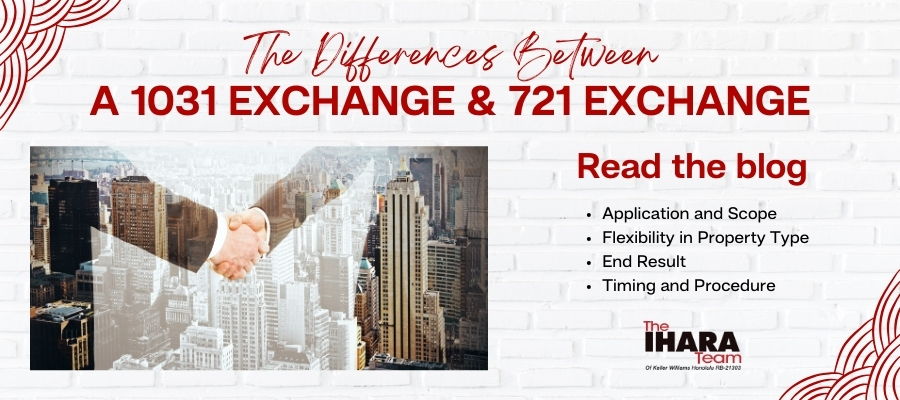The 1031 Exchange and the 721 Exchange are both tax-deferral strategies used in the United States, but they serve different purposes and are applied under different circumstances within the realm of real estate and investment properties. Here’s a breakdown of the key differences between them:

1031 Exchange (Section 1031 of the IRC)
– Purpose: Allows investors to defer paying capital gains taxes on the sale of an investment property by reinvesting the proceeds into another “like-kind” property.
– Eligibility: Available to individuals, C corporations, S corporations, partnerships (general or limited), limited liability companies (LLCs), trusts, and any other taxpaying entities.
– Property Type: The properties exchanged must be of “like-kind,” a term that is broadly interpreted to mean any real estate held for investment purposes, not necessarily similar in type or grade. For example, an investor can exchange vacant land for a commercial building, as both are considered investment properties.
– Timing Restrictions: There are strict timing constraints, including a 45-day period for identifying potential replacement properties and a total of 180 days to complete the exchange from the sale of the relinquished property.
– Ownership Continuity: The investor who sells is the same entity that must purchase the new property.
721 Exchange (Section 721 of the IRC)
– Purpose: Allows investors to defer capital gains taxes by contributing property to a partnership or Real Estate Investment Trust (REIT) in exchange for partnership interests or shares in the REIT, without recognizing a capital gain or loss at the time of the exchange.
– Eligibility: Primarily used by larger investors or entities looking to contribute property to a REIT or a partnership in exchange for shares or units of that entity.
– Property Type: There is no requirement for the properties to be like-kind. The exchange involves contributing real estate to a REIT or partnership in return for ownership interests in that entity.
– Timing Restrictions: Unlike the 1031 Exchange, there are no specific timing restrictions for identifying or completing the contribution of property to a REIT or partnership.
– Ownership Transition: The investor contributes a property to a REIT or partnership and receives shares or partnership interests in return, effectively changing the nature of the investment from direct real estate ownership to ownership of securities.
Key Differences
– Application and Scope: The 1031 Exchange is more commonly used by a wide range of investors seeking to defer capital gains on like-kind property exchanges, while the 721 Exchange is typically used in more specialized circumstances involving contributions to REITs or partnerships.
– Flexibility in Property Type: The 1031 requires like-kind exchanges, whereas the 721 does not have this requirement, allowing for broader flexibility in the type of property contributed.
– End Result: After a 1031 Exchange, the investor ends up owning another real estate property directly. After a 721 Exchange, the investor owns shares or interests in an entity that owns real estate.
– Timing and Procedure: The 1031 Exchange has strict timing rules that must be followed, while the 721 Exchange is more flexible, lacking the same stringent timelines.
Both exchanges offer valuable tax deferral benefits but cater to different investment strategies and objectives. Understanding the nuances and requirements of each can help investors make informed decisions aligned with their investment goals and tax planning strategies.


Leave a Reply